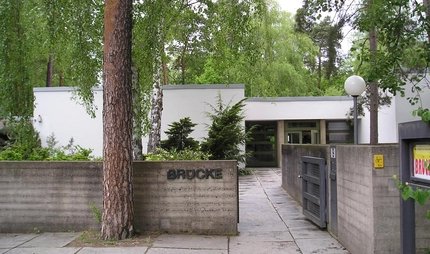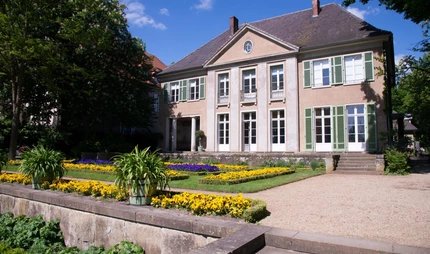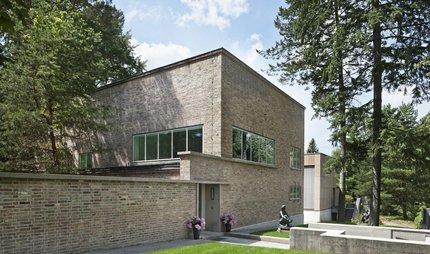
Kunsthaus Dahlem
Sculptures from the post-war period
In June 2015, the Kunsthaus Dahlem is opening in Berlin’s Grunewald area, near the Brücke Museum.
The Kunsthaus Dahlem has an explosive history – built during the Nazi era, the Arno Breker State workshop is now an exhibition space for post-war modernism. It is originally intended to house sculptures for Hitler's Germania project. Sculptor Bernhard Heiliger moves in here after the war, followed by other artists. You can see Heiliger's sculptures in the sculpture garden attched to the museum. The studio is an exhibition space for post-war art of the East and West.
From NS-atelier to postwar modern art museum
Arno Breker comes to prominence in Nazi Germany when Adolf Hitler admires his sculptures. Breker, working with Albert Speer, accompanies Hitler to Paris and builds monumental sculptures that he hopes would adorn Berlin in the future. He is given his own studio which is now Kunsthaus Dahlem. After the war, it's occupied by the Americans and, shortly thereafter, Berlin's sculptors once more. The first such artist, Bernhard Heiliger, moves there in 1949 and stays for 46 years creating almost the entirety of the Sculpture Garden behind the house. The studios are also a haven for other artists such as Emilio Vedova and Wolf Vostell. By 2013, Kunsthaus Dahlem has become a workplace for artists from all over the world – sometimes housing those with scholarships from the DAAD.
Today, the studios are closed – opened in 2015 as an exhibition venue for post-war modernism. You can see sculptures, paintings and photography. Managed by the Bernhard Heiliger Foundation, exhibitions focus on the years between 1945 and 1961. A considerable renovation has been implemented by Berlin's former mayor, Klaus Wowereit. You will first catch sight of the high brick facade of the building, surrounded by the green fringes of Grunewald forest. The main studio is approximately 300 square metres in size. There are high windows – nine metres from the floor to ceiling – letting in plenty of light. Just as high are the wooden doors in the monumental style of the NS architects. In the middle of the room, you are led up a spiral staircase to the gallery. On the white limestone walls are photographs or paintings, depending on the exhibition. Sculptures form the focal point. Kunsthaus Dahlem always exhibits major shows for longer periods. In addition, four times a year there is a new temporary exhibition.
Inside the Kunsthaus Dahlem
- Sculpture garden with more than 20 sculptures by Bernhard Heiliger.
- Grade II listed buildings from the Nazi era, designed by Hans Freese.
- Postwar modernist sculptures.
- Notice boards at the entrance about the gallery's history.
- Workshops for school classes.
Art in Grunewald: Brücke and Max Liebermann
Directly across from the Kunsthaus Dahlem, you can see the Brücke Museum. Since the 1960s, works by a group of artists have been exhibited here. These include expressionist painting by Karl Schmidt-Rottluff, Emil Nolde, Ernst Ludwig Kirchner and Max Pechstein. Max Liebermann is influenced by impressionism. Learn more about him at the Liebermann Villa am Wannsee which is the artist's summer residence from around 1920. The permanent exhibition presents more than 200 paintings and pastels of his garden - all created in this villa.
Our tips for your visit to the Kunsthaus Dahlem
The easiest way to arrive is to take the underground line U3 to the station Dahlem-Dorf. From here, take bus 115 to Finkestraße. It's about a five minute walk to the Kunsthaus Dahlem. The museum is closed on Tuesdays. You can purchase discount tickets in combination with the adjacent Brücke Museum. Guided tours are possible and limited to 30 people. Entry is free for children and young people under 18.



